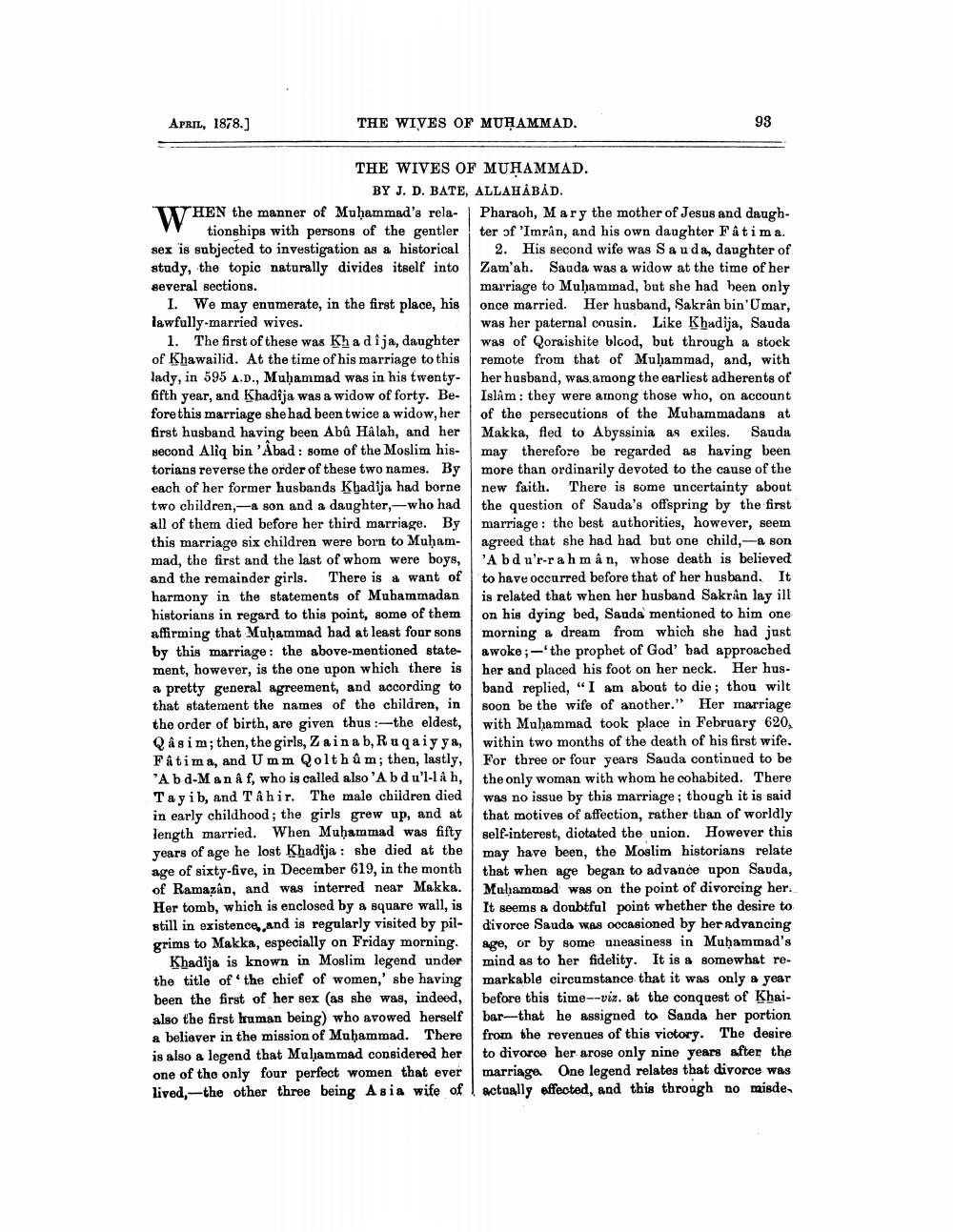________________
APRIL, 1878.]
THE WIVES OF MUHAMMAD.
93
THE WIVES OF MUHAMMAD. BY J. D. BATE, ALLAHABAD.
WH HEN the manner of Muhammad's rela- | Pharaoh, Mary the mother of Jesus and daughtionships with persons of the gentler ter of 'Imrân, and his own daughter Fâ tima. sex is subjected to investigation as a historical 2. His second wife was Sa uda, daughter of study, the topic naturally divides itself into Zam'ah. Sauda was a widow at the time of her several sections. marriage to Muhammad, but she had been only
I. We may enumerate, in the first place, his once married. Her husband, Sakrân bin'Umar, lawfully-married wives. was her paternal cousin. Like Khadija, Sauda was of Qoraishite blood, but through a stock remote from that of Muhammad, and, with her husband, was among the earliest adherents of Islâm: they were among those who, on account of the persecutions of the Muhammadans at Makka, fled to Abyssinia as exiles. Sauda may therefore be regarded as having been more than ordinarily devoted to the cause of the new faith. There is some uncertainty about the question of Sauda's offspring by the first marriage: the best authorities, however, seem agreed that she had had but one child,—a son 'Abdu'r-rahmân, whose death is believed to have occurred before that of her husband. It is related that when her husband Sakran lay ill on his dying bed, Sanda mentioned to him one morning a dream from which she had just awoke; the prophet of God' had approached her and placed his foot on her neck. Her husband replied, "I am about to die; thou wilt soon be the wife of another." Her marriage with Muhammad took place in February 620, within two months of the death of his first wife. For three or four years Sauda continued to be the only woman with whom he cohabited. There was no issue by this marriage; though it is said that motives of affection, rather than of worldly self-interest, dictated the union. However this may have been, the Moslim historians relate that when age began to advance upon Sauda, Muhammad was on the point of divorcing her. It seems a doubtful point whether the desire to divorce Sauda was occasioned by her advancing age, or by some uneasiness in Muḥammad's mind as to her fidelity. It is a somewhat remarkable circumstance that it was only a year before this time--viz. at the conquest of Khaibar-that he assigned to Sanda her portion from the revenues of this victory. The desire to divorce her arose only nine years after the marriage. One legend relates that divorce was actually effected, and this through no misde
1. The first of these was Kha dîja, daughter of Khawailid. At the time of his marriage to this lady, in 595 A.D., Muḥammad was in his twentyfifth year, and Khadija was a widow of forty. Before this marriage she had been twice a widow, her first husband having been Abû Hâlah, and her second Aliq bin 'Abad: some of the Moslim historians reverse the order of these two names. By each of her former husbands Khadija had borne two children, a son and a daughter, who had all of them died before her third marriage. By this marriage six children were born to Muḥammad, the first and the last of whom were boys, and the remainder girls. There is a want of harmony in the statements of Muhammadan historians in regard to this point, some of them affirming that Muḥammad had at least four sons by this marriage: the above-mentioned statement, however, is the one upon which there is a pretty general agreement, and according to that statement the names of the children, in the order of birth, are given thus:-the eldest, Qasim; then, the girls, Zain a b, Ruqaiyya, Fatima, and Umm Qolthûm; then, lastly, "A b d-Man â f, who is called also 'Abdu'l-lâ h, Tayib, and Tâhir. The male children died in early childhood; the girls grew up, and at length married. When Muhammad was fifty years of age he lost Khadija: she died at the age of sixty-five, in December 619, in the month of Ramazan, and was interred near Makka. Her tomb, which is enclosed by a square wall, is still in existence, and is regularly visited by pilgrims to Makka, especially on Friday morning.
Khadija is known in Moslim legend under the title of the chief of women,' she having been the first of her sex (as she was, indeed, also the first human being) who avowed herself a believer in the mission of Muhammad. There is also a legend that Muhammad considered her one of the only four perfect women that ever lived, the other three being Asia wife of




